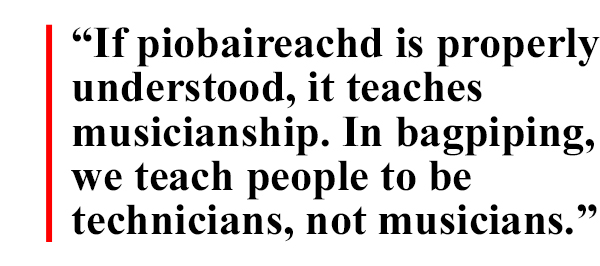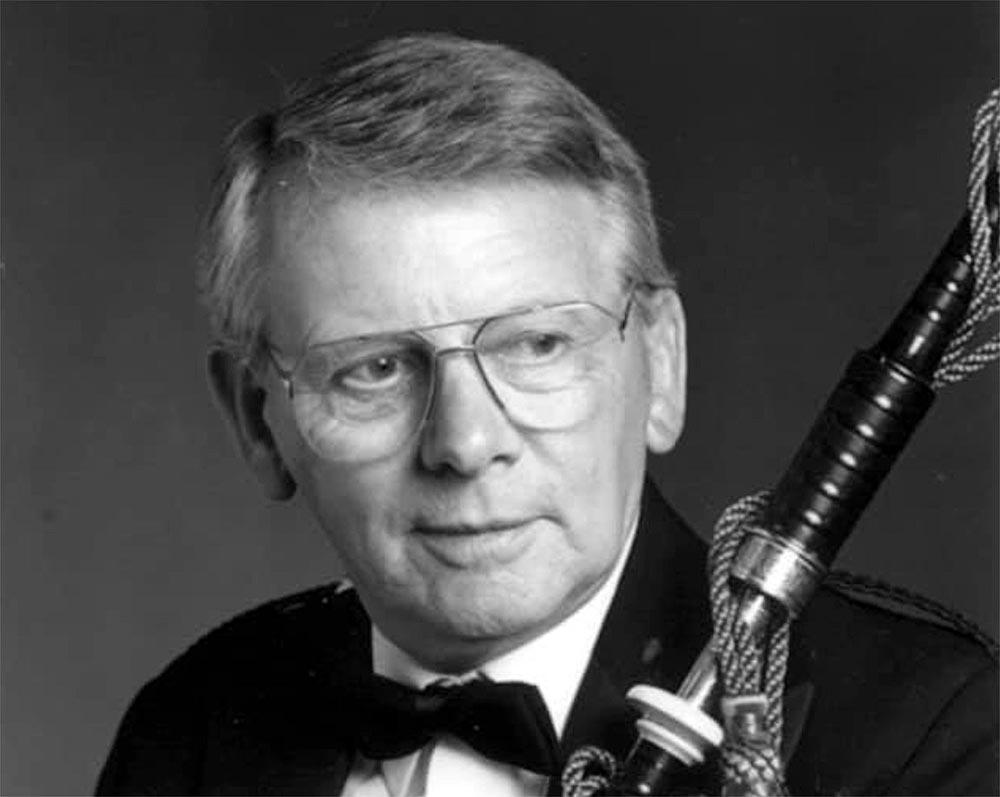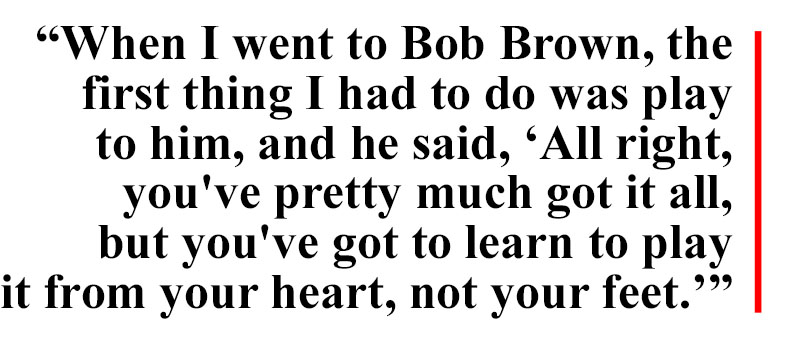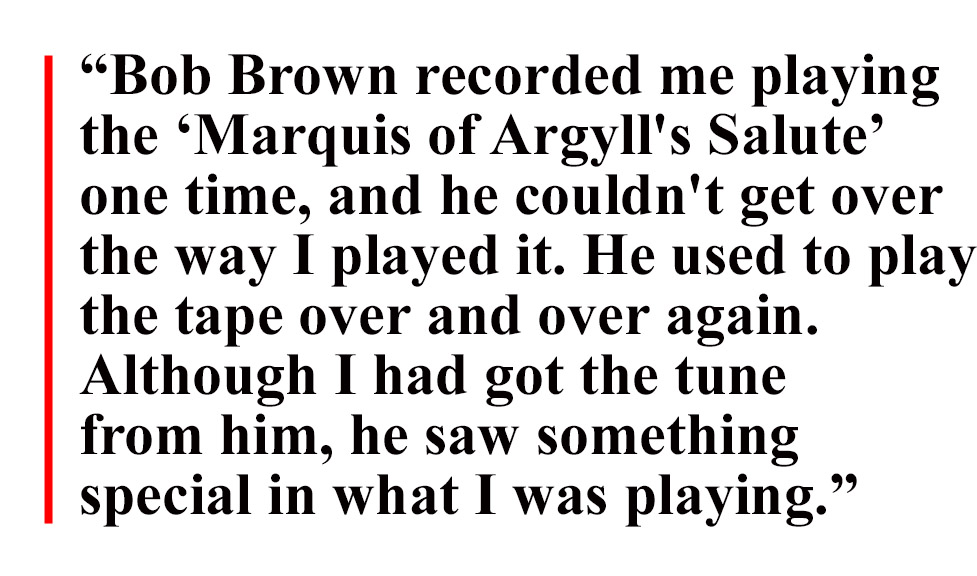Jimmy McIntosh: the pipes|drums Interview from the Archives – Part 2
In Part 1 of Jimmy McIntosh: the pipes|drums Interview from the Archives, the late piping great discussed the piping climate of 1994, including problems between the EUSPBA and the PPBSO, testing and accreditation, and other issues of the time.
In Part 2, he goes into more detail about the teaching styles of Robert Brown, Robert Nicol, Willie Ross and Donald MacLeod.
 Jimmy McIntosh: the 1994 pipes|drums Interview from the Archives – Part 1
Jimmy McIntosh: the 1994 pipes|drums Interview from the Archives – Part 1
February 17, 2021
Jimmy McIntosh passed away in his ninety-sixth year on February 8, 2021, leaving behind a legacy of study and teaching, impacting hundreds of pipers worldwide.
Part 2
pipes|drums: Amateur psychologist time. Give us a one-word response to each of these . . . Donald MacLeod.
Jimmy McIntosh: Genius.
p|d: Bob Brown.
JM: Musician.
p|d: Bob Nicol.
JM: Purist.
p|d: EUSPBA.
JM: Frustrating.
p|d: Dundee.
JM: Well, I was going to say “United,” but then I thought, “Depressing.”
p|d: America.
JM: Opportunity.
p|d: Interesting. Do you worry about the future of solo piping in the eastern U.S. after you stop instructing?
JM: No, there are now four Balmoral Schools in the United States, and now Michael Cusack is the principal instructor, and I am a guest teacher. But as long as I’m here, I will strive to improve and continue passing on knowledge. That’s really my sole function in the piping world, to try to pass on the knowledge that I have gained. If I were living in Ontario, I’d be doing the same thing. If I were living in Timbuktu, I’d be doing the same thing.
p|d: How many piobaireachds do you know?
JM: I’ve never counted, but one of my students has had over a hundred from me. I could safely say that if you took the first eight books of the piobaireachd society, I could sing any of those tunes to you and go through all alternative settings too.
![Instructors at an early 'Balmoral' school of piping and drumming in Greensboro, North Carolina, 1980 (L-R): Tom Kee, Murray Henderson, Alex Duthart and Jimmy McIntosh. [Photo: pipes|drums]](https://www.pipesdrums.com/storage/2021/02/McIntosh_James_1980_03.jpg)
JM: Most of them would be from Brown and Nicol, although I got some of the same tunes from Brown as I got from Donald MacLeod and Willie Ross. There’s only one tune that I got from Willie Ross that I never got from anybody else, and he gave me it because he said he could never get anybody to learn to play it, and I’ve never heard anybody play it, and I never learned to play it, “The Piper’s Salute to His Master.” It’s an obscure tune in Glen’s Collection, and I don’t know, I was just a young lad of 18 when he gave it to me, and he thought, “I’m going to get him to play it,” but I didn’t take to the tune at all.
 p|d: How important is piobaireachd to the overall make-up of a good piper?
p|d: How important is piobaireachd to the overall make-up of a good piper?
JM: Many of my fellow competitors never played piobaireachd, and they were excellent players. But I do think that if piobaireachd is properly understood, it teaches musicianship. In bagpiping, we teach people to be technicians, not musicians. Piobaireachd playing can really teach the musical aspects of bagpipe playing. It’s also very important for the bagpipe tone. The person who plays only light music seldom thinks of the musical aspects of the bagpipe. People who get involved in playing piobaireachd tend to be more interested in the theoretical side of the music, and that’s a good thing. It also gives you an opportunity to do something with your bagpipe that I’ve only heard one other person doing, apart from myself, and that was Bob Brown. He used a vibrato effect for the presentation of the music.
p|d: Are you talking about singing?
JM: No, I’m talking about how you’re blowing your instrument.
p|d: This is something we’ve never heard of, and we’re sure a lot of other people have never heard of. Was this something that Brown would teach?
JM: Well, he never really taught it; he just did it naturally in his playing. You create the vibrato effect either with your throat or with your diaphragm.
p|d: And what would the effect be with the instrument?
JM: Well, you get that sort of vibrato through your instrument. It is a wonderful feeling.
p|d: I would think that during competition, most people might mistake it for being nervous.
JM: No, I don’t think so. It’s not a nervous thing; it’s a controlled thing. Your bagpipe has to be set very finely, and you have to have complete control over your bagpipe. It’s music. If you asked an oboe player, he has to bring vibrato into the pieces he’s playing.
p|d: But that’s written into the score. It would say, “Vibrato.”
JM: Possibly. The night I recorded the cassette with the eight piobaireachds on it, I didn’t know what I was going to play. My bagpipe just seemed to come in, and I was relaxed, and the vibrato comes through in two or three of the pieces.
p|d: I see. Perhaps we should move on. What’s good about piobaireachd playing today, and what’s wrong with piobaireachd playing today?
JM: The quality of the bagpipe sound is good today. The popularity of piobaireachd I think is good, and I’m really excited about it being an international thing. I did a video on oral instruction of piobaireachd for the Arts Council of Pennsylvania, and people are learning in Germany and all over from that video. I think the Piobaireachd Society falls down in that respect. It’s the governing body for piobaireachd, but it is very parochial in its attitude to the piobaireachd world.
I mentioned that in a letter last year suggesting that the Society should have an ambassador who would come to the United States and Canada who would be prepared to come here and have a good discussion, to talk to people on a ground level and to do things. I had lessons from Willie Ross in 1938, which were through the Piobaireachd Society when I was just a young boy. They’re doing nothing like that now as far as I’m aware.

p|d: Do you think The Piobaireachd Society is not living up to its potential and too used to the status quo?
JM: Without a doubt. Angus MacKay’s book tended to standardize the playing or setting of piobaireachd. One of the reasons it was so widely acclaimed at the time was that for the people who were judging piobaireachd, they then had something they could sit down and look at. If pipers didn’t play according to that book, then they were out. There are many nice settings and little things that are no longer going to be played. The students who I work with won’t play things because they say that the judges don’t know them and that they will be penalized. The Piobaireachd Society should also encourage alternative settings.
p|d: Can you name a few standout piobaireachd performances that hold a special place in your mind?
JM: The first one that really stuck in my memory was one night when I had the Tayside Pipers’ Society, and we invited Bob Brown to give a recital, and he played six piobaireachds one after another, and I’ve never heard anything like it. “Cill Chriosd,” ”The Earl of Seaforth’s Salute,” “Patrick Og,” ”The Children.” He wouldn’t accept any money, so we bought him a pound of pipe tobacco. That was his fee. I still have it on tape. Marvellous.
Donald MacPherson playing “Lady MacDonald.” Donald is a marvellous musician. That would have been when I was over in Scotland about four years ago when he won the Open at Oban. The rest of the playing was very poor but he just came in the room and hardly touched his pipes. When I judged Iain Morrison when he won the Clasp at Inverness playing “Lament for the Dead” – that was excellent. The year Amy Garson won Fair Hill, when Seumas MacNeil judged, playing “The Unjust Incarceration” was outstanding.
For myself, I think the year that I was second in the Gold Medal playing the “Battle of the Park” No. 2, is probably one of the best performances I ever gave. Angus MacPherson always sat in the front row with his notebook, and at the end of the day, he came to me and said that was one of the most moving performances that he’d heard in his life at Inverness. He said he was near to tears.
 p|d: What were Brown and Nicol like as teachers?
p|d: What were Brown and Nicol like as teachers?
JM: Bob Brown was the finest teacher I ever had. He was different from anybody else: a very quiet, unassuming, calm person. I never heard Bob Brown say a bad thing about any other piper. He was so enthusiastic that he changed my whole attitude to piping. I had had three good teachers prior to him. Willie Young was my first piobaireachd teacher who was a pupil of Robert Meldrum. Then Donald MacLeod and Willie Ross. But when I went to Bob Brown, the first thing I had to do was play to him, and he said, “All right, you’ve pretty much got it all, but you’ve got to learn to play it from your heart, not your feet.”
I put my pipes away and picked up my practice chanter, but he said, “Oh no,” and from then on, no practice chanter. I had to learn to sing everything and then just play it on the pipes. That’s the way I learned all my tunes. Brown didn’t only teach you the music, but he would talk to you about it, and the background of piping, and he made it so that I would leave there and couldn’t wait to go back. He would conduct you in so many subtle things that nobody else did; nobody else ever talked to me about them.
p|d: How did Bob Brown’s teaching differ from Bob Nicol’s?
 JM: I would say there was the same difference between their teaching and their playing as there was in their personality. I had “The Big Spree” from Bob Nicol after Bob Brown said he wouldn’t teach me the tune because it was a specialty of Nicol. Bob Nicol was a totally different teacher. He wasn’t like Bob Brown in that he didn’t have the same touches of finesse that Brown could impart. Nicol would sit in his chair and have his arm going, and I would always think it was too fast. Then when you would play it back to him, he would say it was too fast. Bob Brown could always appreciate something that wasn’t his way. He would say, “That’s nice.”
JM: I would say there was the same difference between their teaching and their playing as there was in their personality. I had “The Big Spree” from Bob Nicol after Bob Brown said he wouldn’t teach me the tune because it was a specialty of Nicol. Bob Nicol was a totally different teacher. He wasn’t like Bob Brown in that he didn’t have the same touches of finesse that Brown could impart. Nicol would sit in his chair and have his arm going, and I would always think it was too fast. Then when you would play it back to him, he would say it was too fast. Bob Brown could always appreciate something that wasn’t his way. He would say, “That’s nice.”
He recorded me playing the “Marquis of Argyll’s Salute” one time, and he couldn’t get over the way I played it. He used to play the tape over and over again. Although I had got the tune from him, he saw something special in what I was playing.
For example, Nicol gave me “The Big Spree,” which I broadcast, and when I came up to him the next time I saw him, he said, “You didn’t get that right.” I said, “What did I not get right?” and he said, “You cut that first C.” [He sings a phrase from the ground with a cut C.]
With Nicol, it was always “Johnny, Johnny MacDonald, that’s not the way Johnny played it.” He was unforgiving and pure on John MacDonald’s way of playing. They differed on different tunes and agreed to differ. Bob Brown was the nice, quiet, gentle type; Bob Nicol was more abrupt, you know, and there was the same difference in their playing. Bob Brown was very subtle in lots of things he did in his playing, whereas Bob Nicol was very positive, and most people consider Bob Nicol the better player. Bob Brown’s son considers Bob Nicol a better player than his dad.
p|d: Students of Brown and Nicol sometimes seem to hold an allegiance to their style of playing and teaching. You are perhaps the person most identified with such a comment. Is it healthy for music – and particularly piobaireachd – to be rigidly tied to one style of playing?
JM: No, and I would like to know who that statement comes from.
p|d: It comes from memories of some of the Balmoral Schools in the early-1980s.
JM: Ah, but I don’t say that, though. It’s a pretty general opinion, and it doesn’t only apply to Brown and Nicol. I’ve heard the same said about Donald MacLeod and John MacFadyen and John MacLellan and others, and I’ve been on the receiving end of it during my career.
People who really know me, who have studied with me, would agree that if I’m teaching them a tune, I might say there are three alternative ways of playing this tune. And I go over all of the alternative ways with them. And I say, Now it’s up to you which way you play it. I’ll say, This is the way I play it, this is the way Bob Brown played it, this is the way Bob Nicol played it, this is the way Donald Macleod played it. I don’t discourage my students from playing different settings in front of other judges.
There are teachers in Canada who won’t let their students play in front of me or discourage them from playing in front of me, and that’s terrible. One particular person once sat at the side of the competition platform in the piobaireachd. I asked this person why he wasn’t playing, and he claimed his pipes weren’t going. I offered to lend him my pipes because my pipes were in great shape. He said, “Oh, no, I won’t bother.” Later that evening I was standing with another judge and that competitor, and the other judge turned around and said, “Boy, your pipes were singing this morning.”
When I was in Ontario attending the seminar for the judges’ examination, I was astonished to hear it said that we’ve got to judge two ways in Ontario. I said, “How do you mean, ‘two ways’?” I was told you’ve got to judge normally in piobaireachd, and then we’ve got to judge differently for so-and-so’s students.
p|d: Who would make a comment like that?
JM: Well, it was just something that came up in what we were talking about and what we were doing with judging. The implication is that I would give a prize to someone because they are my student. There is no way that I would jeopardize the reputation that I have tried to build in my piping career just to give somebody a prize that is really of very little importance in piping. My reputation is far more important to me than a piobaireachd prize. If I’m giving students tuition and guidance, I don’t really need to give them prizes.
Stay tuned for Jimmy McIntosh: the pipes|drums Interview from the Archives – Part 3 coming soon.
Related
 Jimmy McIntosh: the 1994 pipes|drums Interview from the Archives – Part 1
Jimmy McIntosh: the 1994 pipes|drums Interview from the Archives – Part 1
February 17, 2021


NO COMMENTS YET